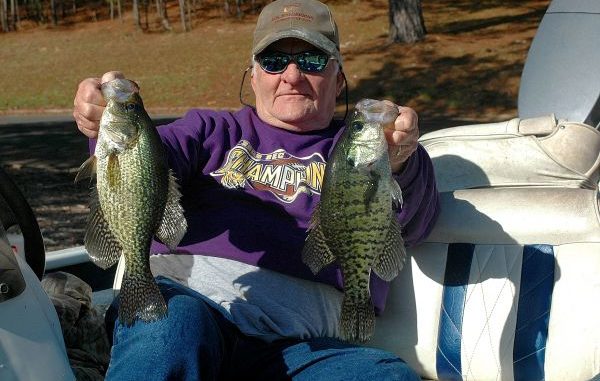
Another location on Glynn Lavergne’s rotating itinerary is Chicot Lake — 2,000 acres of flooded cypress/tupelo located north of Ville Platte within the interior of Chicot State Park.
In February, Lavergne and his fishing partners will be mainly working hyacinth beds and patches of alligator weed by vertically jigging Stanley Wedgetails and tubes.
To get into through the thick hyacinths, Lavergne will use a two-prong rake to make holes in the vegetation. He sometimes uses the same tool to open up dense patches of alligator weed.
“It is impossible to get that small tube jig or Wedgetail through the hyacinths if you don’t do this,” Lavergne said. “You want to pull the hyacinths out of the way to make a hole of about 12 inches in diameter. These hyacinths sometimes have long root tentacles, so you’ll have to pull these away.”
I have done this before with Lavergne on many occasions, and somehow there will still be slab crappie below despite the disturbance on top.
“Once you feel the bottom (approximately 5 to 6 feet down), you want to work that jig upwards 6-inches at a time,” Lavergne said.
When the spawn occurs in late February and early March, Lavergne will just move shallower near the banks where other hyacinth and alligator weed patches occur because he has found that crappie will spawn under the hyacinths.
Although small spinners and spinnerbaits are great in many reservoirs during the crappie spawn, Lavergne will use the Stanley Mini Wedgetail Runner after the spawn — rolling the tiny spinnerbait over submerged grass patches.
“During the spawn, spinnerbaits just can’t be run through the hyacinths and alligator weed because of the thick vegetation,” he explained. “But I sure will catch many after the spawn with spinnerbaits when the sac-a-lait are transitioning to attack small shiners nearby and on the edges of these areas.”
Following the spawn, Lavergne will make long casts with a small float above his Wedgetails and tubes to get to these sac-a-lait on the edges.
Directions to Chicot: When traveling south on I-49 from Alexandria, exit on Louisiana Highway 106 South. Turn left off Louisiana 106 onto Highway 3042 south, and continue to the main entrance of Chicot State Park.
From Opelousas, exit I-49 on U.S. Highway 167 and drive toward Ville Platte. In Ville Platte, turn right onto state Highway 3042 North (Dupre Street), and then left onto state Highway 3042 West (Lincoln Road). Veer right onto Highway 3042/Chicot Park Road. Park entrance is about 7 miles.
There are two launches on the west side of the park, so you may want to view a map of the area which can be found online at www.crt.state.la.us/parks/chicot/imgs/parkmap.pdf.